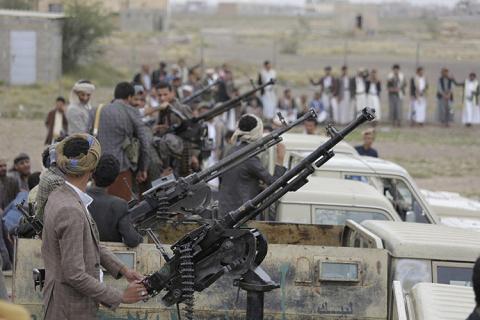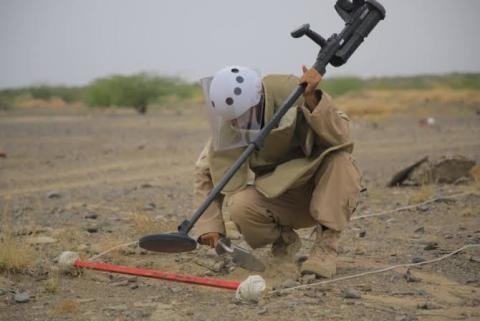Time Is Running Out to save the Truce in Yemen


The deadline to extend the truce in Yemen is fast approaching, and without serious steps to save it, the truce could fall apart. Despite its flaws, the first nationwide cease-fire in more than seven years of war has brought some relative hope to Yemen. Agreed to back in April for an initial two months, and then extended for another two months in June, the U.N.-brokered truce between Yemen's Houthis and the Saudi-led coalition fighting them "offers a rare opportunity to pivot towards peace that should not be lost," as Hans Grundberg, the U.N. special envoy to Yemen, told the U.N. Security Council.
Yet the Houthis, who are aligned with Iran, have indicated that they will not accept an extension of the truce without significant changes, especially the easing of the ongoing blockade of Yemen. Just in the past few days, the Houthis' Supreme Political Council declared that it would not extend the truce at all, as it blasted U.S. President Joe Biden's visit to Saudi Arabia, where he announced his agreement with the Saudi leadership to "to work together to deepen and extend" the cease-fire. "The truce, which the aggressors did not abide by the implementation of its terms, represented a shocking and disappointing experience that cannot be repeated in the future," the Houthi council said in a statement.
The U.N. is pushing for a six-month extension of the truce, and has reportedly presented its proposal to both the Houthis and the Saudi-led coalition. But an agreement on extending the truce again will only happen if Yemen's warring parties act responsibly and fairly. The United States has a role to play as well. President Biden and the U.S. Congress have an enormous amount of leverage that can be used to ensure that the truce continues and Yemen's peace process stays on track.
The framework agreement of the initial two-month truce, which took effect on the first day of Ramadan, included a halt to all offensive military operations; the entry of 18 fuel ships into the port of Hodeida and two commercial flights per week to Jordan and Egypt out of Sana'a International Airport, both blockaded for years by the Saudi-led coalition; an invitation by the U.N. special envoy to a meeting on opening roads in Houthi-besieged Taiz and other governorates to facilitate movement and access; and engagement on U.N. proposals to end the war. On June 2, at the eleventh hour, the parties agreed to a two-month extension.
While the truce has held tenuously for nearly four months, a welcome reprieve in a country exhausted and devastated by so much war and humanitarian suffering, its basic terms have not been fully implemented, by either side. But some of its key provisions are working—perhaps most of all the cessation of cross-border attacks by both the Saudi-led coalition and the Houthis. This is the first extended period of time without sustained Saudi airstrikes or drone attacks by the Houthis over Yemen's border since the start of the war in March 2015. According to the Norwegian Refugee Council, the number of Yemeni civilians killed and injured was reduced by over 50 percent during the first month of the truce, from April to May. Many of those civilian deaths before the truce were from Saudi airstrikes.
Despite the sharp reduction in violence, Yemeni civilians have still been killed during the truce—95 during its first month—largely because of landmines and unexploded ordnance. "That people are still being injured and killed by landmines and improvised explosive devices, shows the critical need for a long-lasting peace, so that that these remnants of war can be removed and more lives saved," Erin Hutchinson, the Yemen country director for the Norwegian Refugee Council, said in a news release.
Yet in many ways the truce still isn't working, based on the very terms of its agreement. The Houthis have been severely frustrated by the lack of progress on lifting the Saudi-led blockade. Only 24 out of 36 fuel ships agreed to in the truce have entered Hodeida's port so far, according to the United Nations' own assessments. U.N.-inspected vessels are still subject to significant delays in the coalition holding area offshore, causing further price increases in Yemen. And only 21 flights have been allowed in and out of Sana'a; there were supposed to be 36 over the four months of the truce, with two a week. Of those 21 flights that have operated, all but one has been to Amman, despite Cairo also agreeing to regular flights from Yemen's capital.

Yemeni officials on Monday condemned arrests and prosecutions by the Iran-backed Houthi militia directed against media, journalists and celebrities…

Yemen's warring parties are gearing up for new waves of conflict in 2023 amid a lack of decisive steps towards sustainable peace, adding to the suf…

The UAE will help to recruit doctors and deliver crucial supplies for hospitals in Yemen under a major healthcare drive. The Khalifa bin…